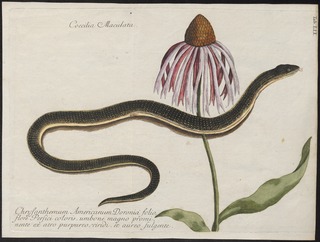
Acontias is a genus of limbless skinks, the lance skinks, in the African subfamily Acontinae. Most are small animals, but the largest member of the genus is Acontias plumbeus at approximately 40 cm (16 in) snout-vent length. All members of this genus are live-bearing sandswimmers, with fused eyelids. A recent review moved species that were formerly placed in the genera Typhlosaurus, Acontophiops, and Microacontias into this genus, as together these form a single branch in the tree of life. This new concept of Acontias is a sister lineage to Typhlosaurus, and these two genera are the only genera within the subfamily Acontinae.

Typhlosaurus is a genus of African lizards, one of a number of genera of limbless lizards in the skink family (Scincidae). This group was recently revised with most species formerly attributed to Typhlosaurus now placed in Acontias. The current definition of Typhlosaurus includes five attenuate body legless lizards from southwestern Africa. This is the sister genus to Acontias, which together form the well supported Afrotropical subfamily Acontinae.

Acontias breviceps, the shorthead lance skink or shortheaded legless skink, is a species of viviparous, legless, fossorial lizards occurring along the southern and eastern sections of the Great Escarpment in South Africa. It may grow up to 10 centimetres (3.9 in) long.

Acontias percivali, also known commonly as Percival's lance skink, Percival's legless lizard, and the Tanzanian legless lizard, is a species of small, legless (snake-like) lizard in the family Scincidae. The species is endemic to Africa.

The woodbush legless skink is a species of legless skink. It is found in the Wolkberg mountains of Limpopo Province, South Africa. Females of the species give birth to live young. This lizard species was formerly placed in a monotypic genus as Acontophiops lineatus. Morphologically the genus shows similarities to Acontias cregoi and a recent review placed both of these within the genus Acontias, which, as Acontias lineatus was already occupied, required a new name for this species.

Acontias gracilicauda, the slendertail lance skink or thin-tailed legless skink, is a species of skink. It is found in the Republic of South Africa and Lesotho. Acontias namaquensis was formerly included in this species as a subspecies, but is now recognized as a distinct species.

Acontias meleagris, or the Cape legless skink, is a species of skink found in the southern Cape of South Africa. It has no limbs, like most members of the subfamily Acontinae.
Vivian Frederick Maynard FitzSimons, born in Pietermaritzburg, was a notable herpetologist in South Africa. Also, he contributed to the collection of spermatophyte samples for the National Herbarium which has become part of the South African National Biodiversity Institute at the Pretoria National Botanical Garden. In 1937, together with Anna Amelia Obermeyer, he collected some of the earliest plant specimens from the Eastern Highlands of Rhodesia.
Nessia layardi, commonly known as Layard's snake skink or Layard's nessia, is a species of skink, a lizard in the family Scincidae. The species is endemic to the island of Sri Lanka.
Acontias albigularis, the white-throated legless skink, is a species of lizard in the family Scincidae. It is endemic to South Africa, where it is found under flat rocks on the montane grasslands and shrublands of the Mpumalanga escarpment. The species was originally regarded as a population of the shorthead lance skink.
Acontias aurantiacus, the golden blind legless skink, is a species of lizard in the family Scincidae. It is found in Zimbabwe, Mozambique, Botswana, and South Africa.

Acontias cregoi, commonly known as Cregoe's legless skink, Cregoi's blind legless skink, and Cregoi's legless skink, is a species of lizard in the family Scincidae. The species is endemic to South Africa.
Acontias fitzsimonsi, Fitzsimons' legless skink or Fitzsimon's legless skink, is a species of lizard in the family Scincidae. It is endemic to South Africa.
Acontias gariepensis, the Mier Kalahari legless skink, is a species of lizard in the family Scincidae. It is found in Namibia, Botswana, and South Africa.

Acontias kgalagadi, the Kalahari burrowing skink or Kgalagadi legless skink, is a species of lizard in the family Scincidae. It is found in Namibia, Botswana, South Africa, and Angola.

Acontias lineatus, known commonly as the striped dwarf legless skink or lined lance skink, is a species of lizard in the family Scincidae. It is found in South Africa and Namibia.
Acontias namaquensis, the Namaqua legless skink or Namaqua lance skink, is a species of lizard in the family Scincidae. It is endemic to Little Namaqualand, Northern Cape, South Africa.

Acontias plumbeus, the giant legless skink or giant lance skink, is a species of lizard in the family Scincidae. It is found in South Africa, Eswatini, Mozambique, and Zimbabwe.
Scolecoseps acontias, also known commonly as the sandy limbless skink, is a species of lizard in the family Scincidae. The species is endemic to Tanzania.










